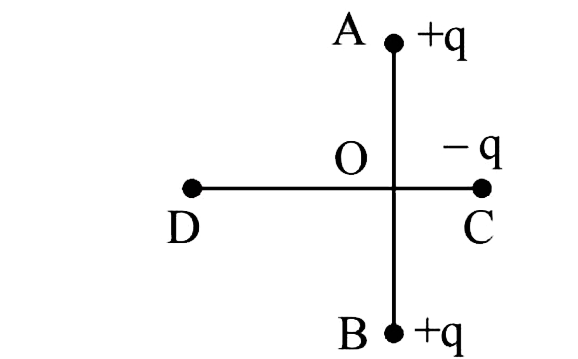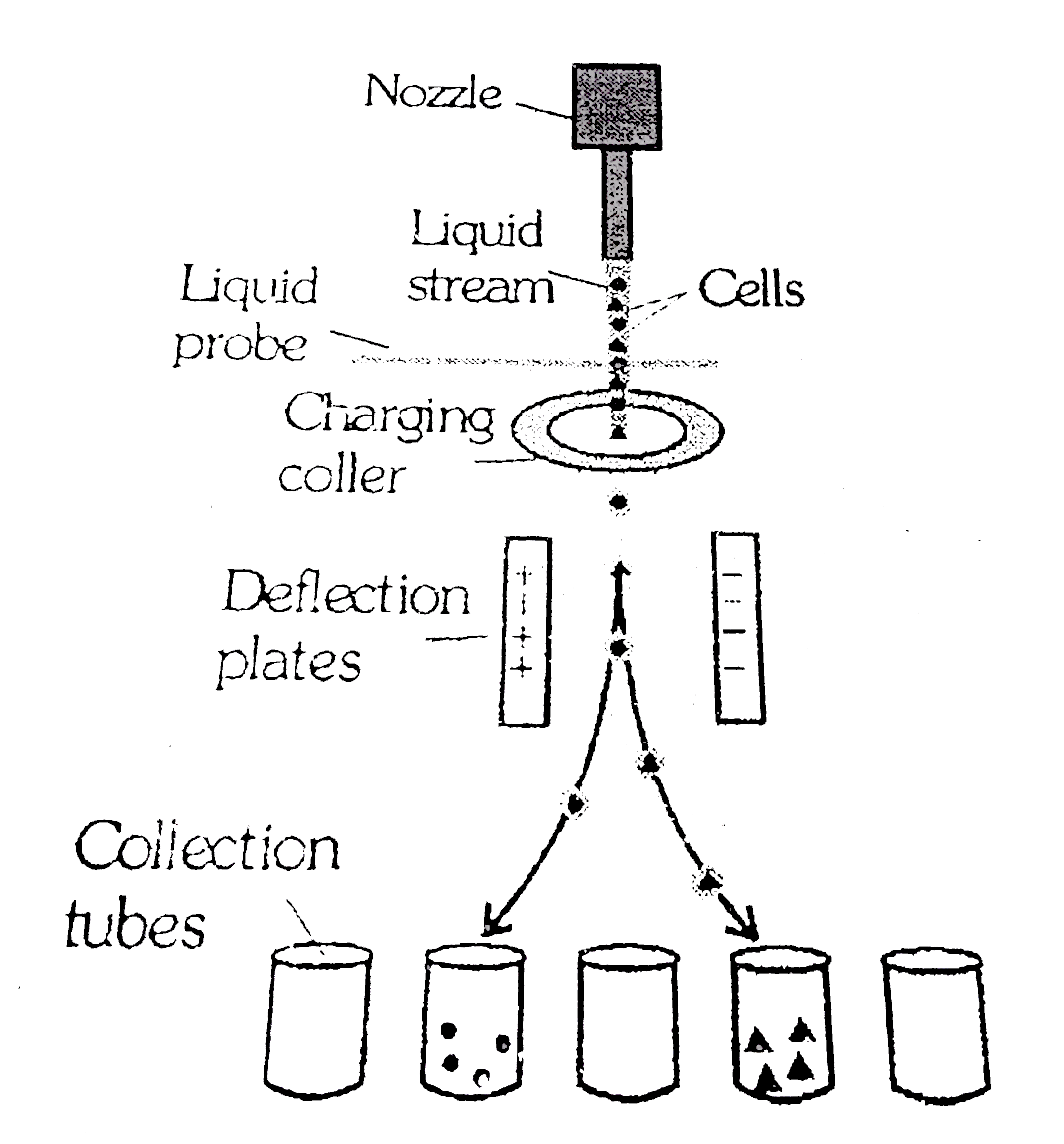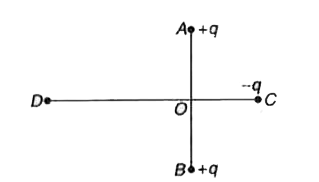Two fixed, equal, positive charges, each of magnitude 5×10−5 coul are located at points A and B separated by a distance of 6m. An equal and opposite charge moves towards them along the line COD, the perpendicular bisector of the line AB.
The moving charge, when it reaches the point C at a distance of 4m from O, has a kinetic energy of 4 joules. Calculate the distance of the farthest point D which the negative charge will reach before returning towards C.
 Solution in Gujrati
Solution in Gujrati
The correct Answer is:8.48m from O

COME: KC+UC=KD+UD
4+2[Kq×(−q)5]=0+(Kq×−2r)
4−2×9×109×25×10−105
=−2×9×109×25×10−10r,r=9m
OD=√AC2−OA2=√92−32=8.48m
Topper's Solved these Questions
- MISCELLANEOUSBOOK - ALLEN CHAPTER - MISCELLANEOUSEXERCISE - Exersice-04[B]
16 Videos
- MISCELLANEOUSBOOK - ALLEN CHAPTER - MISCELLANEOUSEXERCISE - Exercise-05(A)
35 Videos
- MISCELLANEOUSBOOK - ALLEN CHAPTER - MISCELLANEOUSEXERCISE - Comprehension 9
2 Videos
- KINEMATICS (MOTION ALONG A STRAIGHT LINE AND MOTION IN A PLANE)BOOK - ALLEN CHAPTER - KINEMATICS (MOTION ALONG A STRAIGHT LINE AND MOTION IN A PLANE)EXERCISE - BEGINNER S BOX-7
8 Videos
- PHYSICAL WORLD, UNITS AND DIMENSIONS & ERRORS IN MEASUREMENT BOOK - ALLEN CHAPTER - PHYSICAL WORLD, UNITS AND DIMENSIONS & ERRORS IN MEASUREMENT EXERCISE - EXERCISE-IV
7 Videos
Similar Questions
Two small balls having the same mass and charge and located on the same vertical at heights h1 and h2 are thrown in the same direction along the horizontal at the same velocity v. The first ball touches the ground at a horizontal distance R from the initial vertical position. At what height h2 will the second ball be at this instant? Neglect any frictional resistance of air and the effect of any induced charge on the ground.
View SolutionOn moving a charge of 20 coulomb by 2cm, 2J of work is done , the potential difference between the points is .
View SolutionFlow cytometry, illustrated in the figure, is a technique used to sort cells by type. The cells are placed in a conducting saline solution which is then forced from a nozzle. The stream breaks up into small droplets, each containing one cell. A metal collar surrounds the stream right at the point where the droplets seprate from the stream. Charging the collar polarizes the conducting liquid, causing the droplets to become charged as they break off from the steam. A leser beam probes the solution just upstream from the charging collar, looking for the presence of certain types of cells. All droplets containing one particular type of cell are given the same charge by the charging collar. Droplets with other desired types of cells receive a different charge, and droplats with no desired cell receive no charge. The charged. The charges droplets then pass between two parallel charged electrodes where they receive a horizontal force that directs force that directs them into different collection tubes, depending on air charge.

View SolutionA football player kicks a ball at an angle of 30∘ with an initial speed of 20 m/s. Assuming that the ball travels in a vertical plane, calculate (a) the time at which the ball reaches the highest point (b) the maximum height reached (c) the horizontal range of the ball (d) the time for which the ball is in the air, (g=10m/s2)
View SolutionAssertion : Gravitational forces do not depend on the medium between the masses.
Reason : Mediating particle responsible for gravitational force is graviton.
View SolutionTwo fixed, equal, positive charges, each of magnitude 5×10−5 coul are located at points A and B separated by a distance of 6m. An equal and opposite charge moves towards them along the line COD, the perpendicular bisector of the line AB.
The moving charge, when it reaches the point C at a distance of 4m from O, has a kinetic energy of 4 joules. Calculate the distance of the farthest point D which the negative charge will reach before returning towards C.

View SolutionTwo charges +Q each are fixed at points C and D. Line AB is the bisector line of CD. A third charge +q is moves from A to B, then from B to C
View SolutionTwo equal charges q of opposite sign are separated by a small distance 2a ,The electric intensity E at a point on the perpendicular bisector of theline joining the two charges at a very large distance r form the line is
View SolutionTwo point charges of 1muC and -1muC are separated by a distance of 100 Å. A point P is at a distance of 10 cm from the midpoint and on the perpendicular bisector of the line joining the two charges. The electric field at P will be
View SolutionTwo equal and opposite charges separated by a finite distance is
View SolutionTwo point charges −2nC and +8nC are separated in air by a distance of 0.10m.Find the position of the neutral point along the line joining the 2 point charges.
View SolutionTwo fixed charges "A" and "B" of 5μC each are separated by a distance of "6m" .C is the mid point of the line joining "A" and "B" .A charge Q of −5μC is shot perpendicular to the line joining "A" and "B" through "C" with a kinetic energy of "0.06" J. The charge 'Q' comes to rest at a point "D" .The distance "CD" is (a) 3m (b) √3m (c) 3√3m(d) 4m
View Solutionदो धन आवेश q,q(q=5×10−5 कूलॉम) बिन्दुओं A व B पर स्थिर हैं। जिनके बीच 6 मी की दूरी है। एक अन्य आवेश -q रेखा AB के लम्ब अर्दधक (perpendicular bisector) COD के अनुदिश चलता है। जब यह O से 4 मीटर बिंदु C तक पहुँचता है तो इसकी गतिज ऊर्जा 4 जूल है। उस दूरस्थ बिन्दु D की O से दूरी ज्ञात कीजिए जहाँ पहुँच कर यह पुन: C की ओर लौटने लगेगा।

View Solution5μC के दो स्थायी आवेश A और B को 6m की दूरी पर रखा गया है। C , A और B को जोड़ने वाली रेखा का मध्य बिन्दु है। एक −5μC के आवेश 'Q' को A तथा B को जोड़ने वाली रेखा के लंबवत् C की ओर 0.06 J की गतिज ऊर्जा के साथ छोड़ा जाता है। आवेश 'Q' एक बिन्दु D पर विराम में होगा। CD की दूरी होगी :
View Solutionदो समान किन्तु विपरीत आवेशों को मिलाने वाली रेखा की लम्ब अर्द्धक रेखा के किसी बिन्दु पर : -
View SolutionTwo point charges of 1μCand−1μC are separated by a distance of 100 Å. A point P is at a distance of 10 cm from the midpoint and on the perpendicular bisector of the line joining the two charges. The electric field at P will be
View Solution
